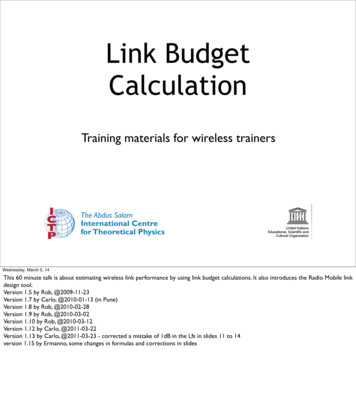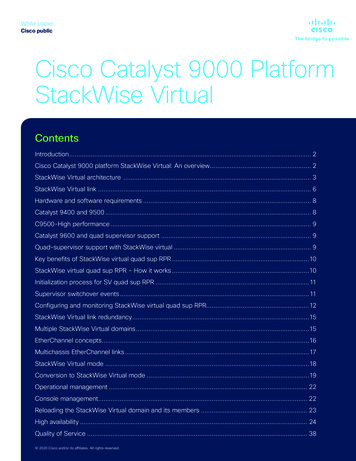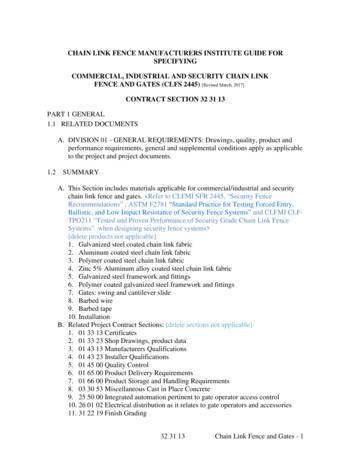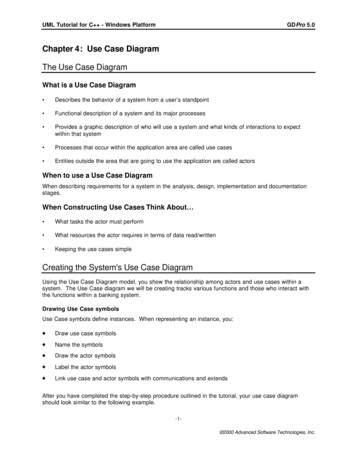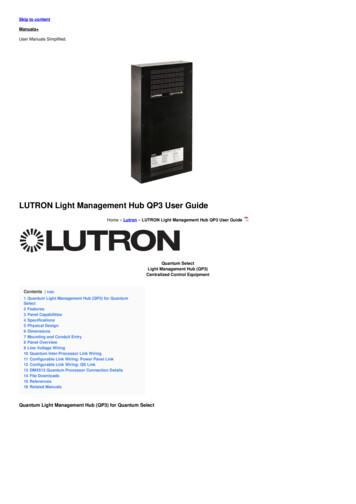
Transcription
Research ReportThe Link BetweenVENTILATOR-ASSOCIATEDPNEUMONIA ANDTHE MOUTHThe intersection of VAP, COVID-19, oral health and equitySUGGESTED CITATION:Thakkar, M, Linson, M, Tranby, E. September 2020. The Link Between Ventilator-Associated Pneumoniaand the Mouth: The Intersection of VAP, COVID-19, oral health, and equity. Boston, MA.DOI: 10.35565/DQP.2020.2014Copyright 2020 DentaQuest DOI: 10.35565/DQP.2020.2014
AUTHORSMadhuli Thakkar, BDS, MPHBiostatistician, Analytics & EvaluationDentaQuest Partnership for Oral Health AdvancementMaya Linson, MSExternal Communications Manager, Public RelationsDentaQuestEric Tranby, PhDData & Impact Manager, Analytics & EvaluationDentaQuest Partnership for Oral Health AdvancementCopyright 2020 DentaQuest DOI: 10.35565/DQP.2020.2014
KEY FINDINGSRoughly 14% of Medicaid patients on mechanical ventilation had a ventilatorassociated pneumonia (VAP) diagnosis.Preventive dental visits decreased the likelihoodof acquiring VAP.At least one preventive dental visit within threeyears reduced the likelihood of a VAP diagnosisby 22%.Black patients are more likely than whitepatients to be diagnosed with VAP.Patients with one or more comorbidities are atsignificantly greater risk for VAP.1
The COVID-19 pandemic made headlines in March 2020 in part becausemore patients than ever were relying on mechanical ventilation1 to survive andhospitals struggled with resource capacity. These ventilated patients alreadyhave depressed immune systems, making them more prone to secondaryinfections, including those caused by bacteria that grow in the oral cavity andactively travel to the lungs.2 These patients are highly susceptible to ventilatorassociated pneumonia (VAP), compounding the risk of adverse outcomes,including death.3WHAT IS VENTILATOR-ASSOCIATED PNEUMONIA (VAP)?VAP is the second most common hospitalacquired infection (HAI) and the leading causeof HAI deaths among critically ill patients.4 VAPis likely to occur in 10-20% of patients who aremechanically ventilated for 48 hours or more.5Both serious and deadly, VAP commonly occurswhen a patient is connected to mechanicalventilation and bacteria travel from the oralcavity or breathing equipment into the lungs.6The airway tube disrupts natural defenses thathelp maintain a healthy oral microbiome, whichrefers to a healthy balance of organisms withinthe mouth and throat that protect againstdisease. This disruption creates an environmentripe for pathogens and thus increases risk ofsuperinfections like VAP, particularly amongalready critically ill patients.We conducted an analysis to understand therelationship between oral health and VAP, andthe results indicate that improving oral healthcare and addressing existing disparities can helpmitigate the number and frequency of VAP cases.This study included 9,279 Medicaid patients whoTube inserted into airwaythrough the mouthOral bacteriatrachealungsFig. 1: How oral bacteria enter the lungsrelied on mechanical ventilation for 48 hours orlonger. Within this cohort, 14% (1,284 patients)were diagnosed with VAP.2
HOW ARE ORAL HEALTH AND VAP RELATED?Given that VAP commonly stems from bacteriathat travel from the mouth to the lungs, weexamined VAP incidence data and past routinepreventive dental visit data. We found that foreach additional routine dental visit the patientdiagnosis decreased by 5%, after controlling forconfounding factors including age, race, sex andcomorbidities. Additionally, in a separate modelusing a dual variable for preventive dental visits,we found that those patients who had at leastone preventive dental visit within the previousthree years were 22% less likely to be diagnosedwith VAP.Patients who had at least onepreventive dental visit withinthe previous three years were22% less likely to be diagnosedwith VAPThese findings reveal the importance ofongoing preventive oral care because neglectedor ineffective oral care negatively impacts apatient’s oral microbiome, making these patientsmore susceptible to bacteria-related hospitalinfections. The tooth surface, when not cleaned,may harbor pathogenic organisms. Routinedental visits prevent bacteria and plaqueaccumulation, so fewer pathogens exist in themouth.7had within the previous three years of being puton a ventilator, the predicted probability of VAPPredicted probability of VAP diagnosis bynumber of preventive dental visits012345678910Fig. 2: Adjusted predicted probability of VAP diagnosis by number of preventive dental visits(We categorized number of preventive dental visits as none vs. at least one and ran a separate multivariable regression model)3
Other studies share similar findings and point tohow oral care delivered within the hospital canalso positively impact outcomes. Some research,for instance, suggests interrupting the processof pathogen growth with daily oral care whileventilated significantly decreases time spenton the ventilator and may also reduce VAP riskand ICU length of stay.8, 9, 10, 11 Another studysuggests promoting and maintaining oral healthalong with comprehensive inpatient oral care formechanically ventilated patients can reduce theincidence of VAP. 12Given the demonstrated relationship betweenpreventive dental care and VAP risk, as wellas support from other literature, entering theEntering the hospital with ahealthy mouth could lead toimproved outcomeshospital with a healthy mouth could lead toimproved outcomes for patients reliant onventilation.HEALTH EQUITY AND DISPARITIESMechanical ventilation is a common supportivetreatment6 response to COVID-19, a virus thatlimits immune strength to fight superinfections orHAIs. With reduced immunity, COVID-19 patientsthat acquire VAP are likely to see a decline intheir clinical condition.13play a role: patients with 1 comorbidity were 73%more likely to have a VAP diagnosis comparedto those with none, while patients with 2 or morewere 98% more likely than those with none.Among those patients on mechanical ventilatorsfor 48 hours or longer, we found Black peoplewere 39% more likely than white people to bediagnosed with VAP. And males were 20% morelikely to be diagnosed than females.Studies have shown that coronavirusdisproportionately impacts people of colorand low-income communities and, specifically,counties with higher proportions of Blackpeople.14 In fact, those counties account for 52%of COVID-19 diagnoses and 58% of COVID-19deaths nationally.14In addition, the data shows comorbiditiesRelated, low-income communities and thoseAmong those patients on mechanical ventilators for 48 hours or longer4
that are predominantly Black are associated withhigher rates of chronic disease comorbidities14and poor oral health — both of which are riskfactors for COVID-19 and VAP. Other DentaQuestPartnership data shows Black adults are 22% lesslikely to have had a routine dental visit in the pastyear and 68% more likely to have unmet dentalneeds, compared to their white counterparts.15Together, the data demonstrates compoundingdisparities, meaning these communities notonly are more likely to become infected withcoronavirus, but also are more likely to acquireVAP from poor oral health if treatment includesmechanical ventilation, which is common amongCOVID-19 patients.IMPLICATIONS: COVID-19, ORAL HEALTH AND THE OVERALLHEALTH SYSTEMDuring a pandemic such as COVID-19, longhospital lengths of stay incur a substantialhealth care burden because of a greater needfor ventilators, personal protective equipmentsuch as N95 masks, and more ICU beds. Severalstudies also show VAP adds roughly 40K andseven days to a single hospital stay.16 Thus,reducing the incidence of VAP is a critical stepto ensuring enough available resources to carefor critically ill patients, as well as the chance toimprove outcomes among critically ill patients,given VAP remains a leading cause of hospitaldeaths among this group.4The relationship between both incidence and riskfactors for VAP, COVID-19 and oral disease aresignificant. As noted, disparities are particularlystark among Black communities. Given oralhealth is a common factor across theseconditions, efforts to mitigate the trends shouldalso share a common focus on oral health —both in and out of the hospital.17 These findingsunderscore the need to address social conditions,structural racism, access to care, oral healtheducation and other factors not only to improveoral health outcomes but also to reduce therisk for COVID-19, VAP and even death in Blackcommunities.If we can increase the numberof people getting preventiveoral care, particularly withinthe highest risk communities,we can significantly reduce theincidence of oral disease andthus the burden on our healthcare system and patients’ lives— regardless of coronavirus orany future pandemicOf course, there remains a need for additionalresearch to establish any causal relationshipbetween poor oral health and VAP. Medical anddental professionals also need to collaborate onstandard in-hospital oral hygiene protocols for allpatients, particularly those expected to requiremechanical ventilation. Additional needs includestandard dental evaluation and measures foraccurate tracking.5
Specifically, this evidence makes the case thatthe best way to prevent VAP is three-fold. First,promote effective oral health care and behaviorsin the community; next, be attuned to historicdisparities and thus heighten effective oralcare for patients in anticipation of VAP; andthird, effectively and fully implement oral caremanagement protocols for all ventilated patients.More generally, however, the findings reinforcethe connection between oral health and overallhealth and underscore the breadth of healthissues that ongoing oral health care can protectagainst. If we can increase the number of peoplegetting preventive oral care, particularly withinthe highest risk communities, we can significantlyreduce the incidence of oral disease and thus theburden on our health care system and patients’lives — regardless of coronavirus or any futurepandemic.METHODSThe DentaQuest Partnership used the IBMWatson MarketScan Medicaid Database toexamine inpatient administrative claims datafor Medicaid enrollees. Data was obtained forall patients admitted to an ICU in 2016/2018and received invasive mechanical ventilationfor 48 hours. Within this cohort, cases of VAPwere defined as patients with InternationalClassification of Diseases, 10th Revision, ClinicalModification (ICD-10-CM) diagnosis codeJ95.851 or patients with bacterial pneumoniadiagnoses occurring 48 hours followingintubation.,18, 19 Further, using dental claims dataand Current Dental Terminology (CDT) codes,we identified patients who had any dentalexamination, prophylaxis or preventive visitswithin the three years prior to hospitalization.Individual comorbidities were identified tocreate the Elixhauser comorbidity index basedon ICD-10-CM diagnosis codes.20 The primaryindependent variable was the number of dentalexaminations or preventive visits as a continuousvariable. Other covariates include age in yearsas a continuous variable; sex coded as male vs.female; race categorized as white, Black, Hispanicand other; and Elixhauser comorbidity scorecategorized as zero, one, and two or more. Weused multivariable logistic regression modelsto examine factors associated with incidence ofVAP among patients who received mechanicalventilation for at least 48 hours.6
REFERENCES1.Dries DJ, Marini JJ. Mechanical Ventilation. In: Ronco C, Bellomo R, Kellum JA, Ricci Z, eds. Critical Care Nephrology. 3rd ed. London:Elsevier; Inc.; 2019: 10-21.e2. ISBN 9780323449427. http://www.sciencedirect.com/science/article/pii/ B9780323449427000030.2.Richards, MJ, Edwards JR, Culver DH, Gaynes RP, et al. Nosocomial infections in medical intensive care units in the United States. CritCare Med. 1999;27:887-892.3.Dudoignon E, Caméléna F, Deniau B, et al. Bacterial pneumonia in COVID-19 critically ill patients: a case series. Clin Infect Dis. es A, Niederman MS, Chastre J, et al. International ERS/ESICM/ESCMID/ALAT guidelines for the management of hospitalacquiredpneumonia and ventilator-associated pneumonia: Guidelines for the management of hospital-acquired pneumonia (HAP)/ ventilatorassociated pneumonia (VAP) of the European Respiratory Society (ERS), European Society of Intensive Care Medicine (ESICM),European Society of Clinical Microbiology and Infectious Diseases (ESCMID) and Asociación Latinoamericana del Tórax (ALAT). EurRespir J. 2017;50(3):1700582. DOI:10.1183/13993003.00582-2017.5.Safdar N, Dezfulian C, Collard HR, et al. Clinical and economic consequences of ventilator-associated pneumonia: A systematic review.Crit Care Med. 2005;33:2184-21936.Póvoa H, Chianca GC, Iorio N. COVID-19: An alert to ventilator-associated bacterial pneumonia. Infect Dis Ther. 20-00306-57.Marsh PD, Devine DA. How is the development of dental biofilms influenced by the host? J Clin Periodontol. 2011;38 (Suppl. 11):2835.8.de Lacerda Vidal CF, de Lacerda Vidal AK, de Moura Monteiro Jr. JG, et al. Impact of oral hygiene involving toothbrushing versuschlorhexidine in the prevention of ventilator-associated pneumonia: a randomized study. BMC Infect Dis. 2017;17: 112. https://doi.org/10.1186/s12879-017-2188-0.9.Attar MM, Zaghloul MZ, Menoufy HS. Role of periodontitis in hospital-acquired pneumonia. E Med Heal J. 2010;16(5):563-569.10. Orr CJ, Mitchell M. Prevention of hospital-associated pneumonia using a comprehensive oral hygiene protocol. Sage [Internet]. /21105 Prevention of Hospital Associated Pneumonia Using a Comprehensive OralHygiene Protocol handout.pdf.11. Paju S, Scannapieco FA. Oral biofilms, periodontitis, and pulmonary infections. Oral Dis. 2007;13:508-512.12. Scannapieco FA, Bush RB, Paju S. Associations between periodontal disease and risk for nosocomial bacterial pneumonia and chronicobstructive pulmonary disease. A systematic review. Ann Periodontol. 2003;8:54-69.13. Cunha BA, Brusch JL. Hospital-Acquired Pneumonia (Nosocomial Pneumonia) and Ventilator-Associated Pneumonia. Medscape: Drugsand diseases. view. Updated June 20, 2020. Accessed September 16, 2020.14. Millett GA, Jones AT, Benkeser D, et al. Assessing differential impacts of COVID-19 on black communities. Ann Epidemiol, 2020;47:37-44.ISSN 1047-2797. . DentaQuest Partnership for Oral Health Advancement. New Oral Health Data Reflect Inequities, Barriers. Boston, MA; May 2020.DOI:10.35565/DQP.2020.4001.16. Zimlichman E, Henderson D, Tamir O, et al. Health care-associated infections: a meta-analysis of costs and financial impact on the UShealth care system. JAMA Intern Med. 2013;173(22):2039-2046. DOI:10.1001/jamainternmed.2013.976317. Gupta A, Gupta A, Singh TK, Saxsena A. Role of oral care to prevent VAP in mechanically ventilated Intensive Care Unit patients. Saudi JAnaesth. 2016;10(1):95-97. https://doi.org/10.4103/1658-354X.16948418. Rello J, Ollendorf DA, Oster G, et al. Epidemiology and outcomes of ventilator-associated pneumonia in a large US database. Chest.2002;122(6):2115-2121. DOI:10.1378/chest.122.6.211519. Resende MM, Monteiro SG, Callegari B, Figueiredo PM, Monteiro CR, Monteiro-Neto V. Epidemiology and outcomes ofventilatorassociated pneumonia in northern Brazil: an analytical descriptive prospective cohort study. BMC Infect Dis, 2013;13:119.DOI:10.1186/1471-2334-13-119 https://doi.org/10.1186/1471-2334-13-119.20. Elixhauser A, Steiner C, Harris DR, Coffey RM. Comorbidity measures for use with administrative data. Med Care. 1998;36(1):8-27.7
The DentaQuest Partnership for Oral HealthAdvancement is a nonprofit organizationworking to transform the broken health caresystem and enable better health throughoral health. Through strategic grantmaking,research and care improvement initiatives,we drive meaningful change at the local,state and national levels. The DentaQuestPartnership is affiliated with DentaQuest,a leading U.S. oral health enterprise with amission to improve the oral health of all.FIND OUT MORE ATdentaquestpartnership.orgDentaQuest465 Medford StreetBoston, MA 02129-1454
WHAT IS VENTILATOR-ASSOCIATED PNEUMONIA (VAP)? VAP is the second most common hospital-acquired infection (HAI) and the leading cause of HAI deaths among critically ill patien


